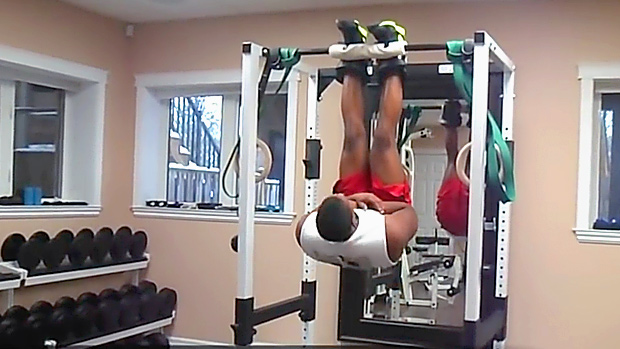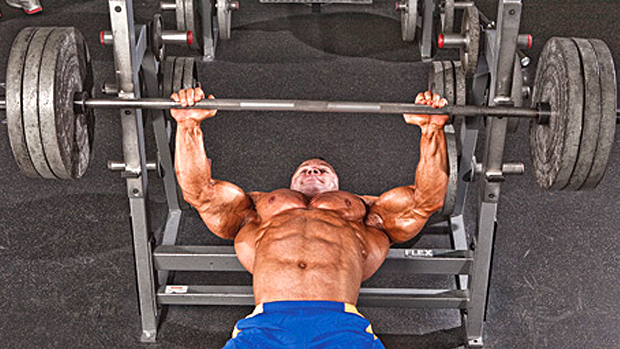Way back in year one of T-Ntaion, Charles Poliquin wrote an article called The One-Day Arm Cure, a program where you basically trained biceps and triceps all day long in an effort to add up to half an inch to your arms in just 24 hours. A lot of people have tried it over the years and the feedback has been mediocre.
Some say they added a little size while others say the program did nothing but make them waste their day off. In the following article, the author provides an alternative plan that may help you finally bump up the caliber of those guns, although not in 24 hours.
Don't be shy. I want an honest answer to the following question and I promise not to tell anybody. Has anyone out there tried "The One-Day Arm Cure" by Charles Poliquin? Or am I the only nut who spent an entire day devoted to training arms? Well, I gotta tell ya, I've had better Sundays at my mother-in-law's house and my arms got a better pump just helping her stir tomato sauce! That's one nutty program.
I can't give full credit (or blame) to Mr. Poliquin for this brainstorm, nor does he credit himself for it. The method was developed and popularized in the various muscle magazines of the 1960's and Mr. Poliquin just refined it. He took a few of his favorite arm exercises such as the seated Zottman curl and the California press and had you perform them every half-hour. Every few hours of the day, you also ate a certain magical combination of foods and supplements.
I tried the program myself, training almost all day from 9am to 7pm. Did I gain between 3/8 to 1/2 inch on my arms five days after completing this program as the article claimed? No. Did my arms shrink for the first 24 hours after this workout as the article also claimed? Yes. And they continued to shrink!
As negative as I sound, I'm in no way picking on Charles Poliquin. He's helped change sports conditioning and bodybuilding training for the better. I've applied many of his training protocols and I credit much of my skills as a trainer to his teachings, except this one. But here's his chance (and yours) to call me and my training methods nuts because I came up with a nutty arm routine of my own: The One-Arm a Day Arm Cure.
Your mission, if you decide to accept it, is to work just one arm (both triceps and biceps) each day, six days a week for six weeks; one day your right arm, the next day your left. Do no other exercises except alternating one of the following each day: squats, bench press, and bent-over barbell rowing.
Note the importance of the other "big three" exercises. You'll fail to get big arms just by working your arms. The whole body must be trained, but not overtrained. By utilizing only the squat, bench, and row, we give the body what I call a "ripple effect." No other exercises (with the exception of the deadlift) give as much stimulation to the muscles involved and to those spread throughout the body.
These big-bang exercises are also powerful growth-hormone stimulators and work your cardiovascular system to an extent unequaled by any aerobic workout. They're simply outstanding movements. Sure, they're tough, but the indirect growth potential for your arms far outweighs the effort required. Besides, you wouldn't be reading this site if you were afraid of a little hard work.
Before I jump right into the basic concept of this program, let me point out that this is an advanced routine, one that would be far too difficult for a beginner (someone with less than a year of fundamental resistance training). I'm about to recommend a course of action by which the advanced bodybuilder can improve the size of his or her arms significantly. At the same time, the actual duration of your workouts will decrease. Don't panic – you read correctly! This program will take less time, but definitely more effort. You'll have to focus and concentrate like never before.
Just make sure you follow the usual guidelines that are designed for you to get the most out of any such workout program: warm-up sufficiently; end a set before your form breaks down; pay attention to proper nutritional, supplemental, and sleep needs; etc. I'm not going to give detailed recommendations on these areas as I feel most experienced bodybuilders have sufficient knowledge of them already. If not, refer to my book, The Turning Point, Chris Aceto's outstanding book, Championship Bodybuilding, or look right here in the previous issues of T-mag.
Follow these five major guidelines:
1 Concentrate on two basic arm exercises (one for biceps, one for triceps) per workout.
The search for magic exercises or programs that suddenly create twenty-one-inch monsters out of matchsticks is useless and time consuming. Forget that! You want to work harder, not longer. I don't try to make weight training more complicated than it needs to be. Forget all these "advanced mad Russian programs" or the "muscle-building secrets of the Bulgarians." I've gotten the best results for my clients and students by sticking with the basics. And that's what we're going to do here.
2 Work as hard and as heavy as possible.
I know, I know, you've heard this one before, but this time you're not only going to do it, you're going to do it right! You should be using your maximum weight as much as possible in this program. I'd define a maximum as one you truly struggle with on the last few reps, with a minimum of cheating. The last rep (the eighth in this program) should leave you breathless and too "cramped" to support the weight any longer. And remember to constantly keep upgrading your poundages. What was a gut-busting struggle to lift three weeks ago should be fairly easy today. Weight has to be steadily and constantly added to your routine to ensure the muscles are always worked to their maximum.
3 Longer isn't better. (At least that's what I tell my wife!)
This is the answer for all those who think they can maintain intensity for their usual twenty sets of biceps and triceps work. You can't! Your goal should instead be to work the muscle as thoroughly as possible in as little time as possible.
The late bodybuilding "guru" Vince Gironda defined true intensity as "doing more work in less time." Look at your workout time as an uninterrupted battle between the weight and yourself. This rules out conversation between sets, lingering at the water fountain, striking and holding a spectacular front double biceps pose, and gazing too long at the silicone goddess on the pec deck machine! Work at a steady, efficient pace at all times and limit your rest between sets and exercises to bare minimum – half a minute to a minute at the most.
4 Keep your movements slow and strict.
Even though I've just preached the necessity of limiting wasted time, that doesn't mean you should try to appear in the Guinness Book of World Records under the heading "World's Fastest Curler." Momentum should not be your training partner! The movements should be slow, smooth and controlled, not jerked up and down, and slow enough to avoid letting gravity and momentum do the work for you.
5 Visualize your goals and concentrate on them.
Remember Arnold saying he imagined his biceps filling the whole room while he was training? Frank Zane will give you the same pitch for utilizing the mind properly to shape the body. Watch the action of the biceps or triceps closely as you train in a sleeveless shirt. This is why one-limb training is effective: all your effort, concentration and sheer force is focused on that one muscle to achieve that one goal – size. Keep that image of the muscle swelling before your eyes for as long as you can after the set. Believe that the food you're digesting that day is going straight to the arm you're training that day to nourish it. By simply thinking size, size will follow.
Okay, let's rip off our shirtsleeves and get to work. Here are the details of the program:
Monday
- A. Squat – 4 sets, 10 reps
The arm workout (right arm only*) - B. Biceps: Seated, Offset-Grip Dumbbell Curl – 4 sets, 8 reps
Sit upright on a regular bench holding a dumbbell in your right hand. The thumb side of your hand should be resting against the inside surface of the dumbbell plate. This is the offset grip. Start the exercise with a neutral grip (as if holding a hammer), and curl the weight while simultaneously supinating your wrist (turning your palm up) as you complete the curling movement.

The purpose of the offset grip is to provide resistance upon supination; otherwise each side of the dumbbell would counterbalance the other as it does during the commonly performed (and overly used) rotational curl. This places emphasis on the supinator muscle of the forearm along with the biceps brachii. The brachioradialis also assists with supination. For added resistance upon supination, I stick a magnetic 1-1/2 pound Platemate to the heavier end of the dumbbell.
- C. Triceps: Decline Dumbbell Triceps Extension – 4 sets, 8 reps
I find this exercise to be one of the most effective for recruiting all three heads of the triceps. You'll find it also allows for a greater stretch than most triceps exercises and the extended range of motion against gravity will literally shock your muscles into new growth.
Start by positioning yourself supine on a decline bench with a dumbbell in your right hand. Make sure to hook your feet under the padded rollers or you'll slide off like a sack of potatoes, making a big loud thump on the ground with your head and blaming it on me when the whole gym starts laughing.
Once you get in position, lift the dumbbell overhead as if you were going to do a bench press. Your grip should be neutral with your palm facing in toward you. Keeping your elbow pointed directly upward (don't let it flare out), lower the dumbbell until the plate makes contact with your right shoulder. Lift the dumbbell back up to the starting position by extending your elbow. Your elbow should be the only moving joint during the exercise.
To jazz this up a little and to recruit the anconeus muscle, rotate the palm down toward the floor as you're reaching the 90-degree angle point of the descent. Make this a slow and gradual rotation as you enter the point where gravity has its most pull. Then, as you come back up to the top, gradually rotate back to the neutral/hammer grip. This added load on the triceps at the toughest part of the movement is a great variation that'll have your tri's smokin'.

Note: Size and/or strength imbalances from left to right are extremely common. If you have an imbalance, you may benefit from applying the weak side rule, as touted by the likes of Ian King, Paul Chek, and even Ah-nuld. Arnold writes in one of his old training booklets, "If you have one arm weaker than the other, a good trick is to do the weak arm first." So let's listen to Arnold and his 22-inch guns and start Monday's workout with your weaker arm to take advantage of Sunday's rest. Your concentration and strength will be at their most efficient.
If you're unsure which arm is the weak one, you'll know by the end of the first week! If you find an imbalance of less than 20%, add an extra set on the weak side. If the imbalance is closer to 50%, cut the rep range down to six on each set (without going to complete muscular fatigue) on the strong arm compared to the eight reps for the weak side. When you do eventually go back to your regular workout routine and return to doing both arms in the same workout, do two extra sets on the weak side for every one set on the strong side until the muscle imbalance is corrected.
Tuesday
- A. Barbell Bench Press – 4 sets, 10 reps
The arm workout (left arm only this time) - B. Seated, Offset-Grip Dumbbell Curl – 4 sets, 8 reps
- C. Decline Dumbbell Triceps Extension – 4 sets, 8 reps
Wednesday
- A. Bent-Over Barbell Row – 4 sets, 10 reps
The arm workout (right arm only) - B. Seated, Offset-Grip Dumbbell Curl – 4 sets, 8 reps
- C. Decline Dumbbell Triceps Extension – 4 sets, 8 reps
Thursday, Friday and Saturday
Begin cycle over starting with left arm
Thursday
Squat/left arm
Friday
Barbell Bench Press/right arm
Saturday
Bent-Over Barbell Row/left arm
Sunday
Rest, recover and rebuild!
Follow the program exactly as given for six weeks. Rest a week, then follow it for another month. Then, drop all arm specialization (if you don't, you'll go stale), and go back to your regular workout routine. Let a good two months pass and maybe go at the routine again, same procedure. If you can stand it, you can try it a third and even fourth time, bringing your arms, ultimately, up to really impressive proportions and detail.
If you like, you may switch arm exercises a bit after following the outlined 11-week schedule. I suggest using the seated incline dumbbell curl or the bent-over dumbbell concentration curl (unsupported) for the biceps. For the triceps, you can try the one-arm reverse grip cable pushdown or the one-arm cable kickback. Just keep the offset dumbbell curl and the decline triceps extension as "staples" of the program.
And, of course, you can perform the deadlift in place of the squat or bent-over row once in a while. Although the name may imply that it's dead, the dreaded deadlift should be alive and well in every bodybuilding, powerlifting, beginning or advanced athlete's program.
That's it. Now it's up to you. How badly do you want those big sculpted arms?




